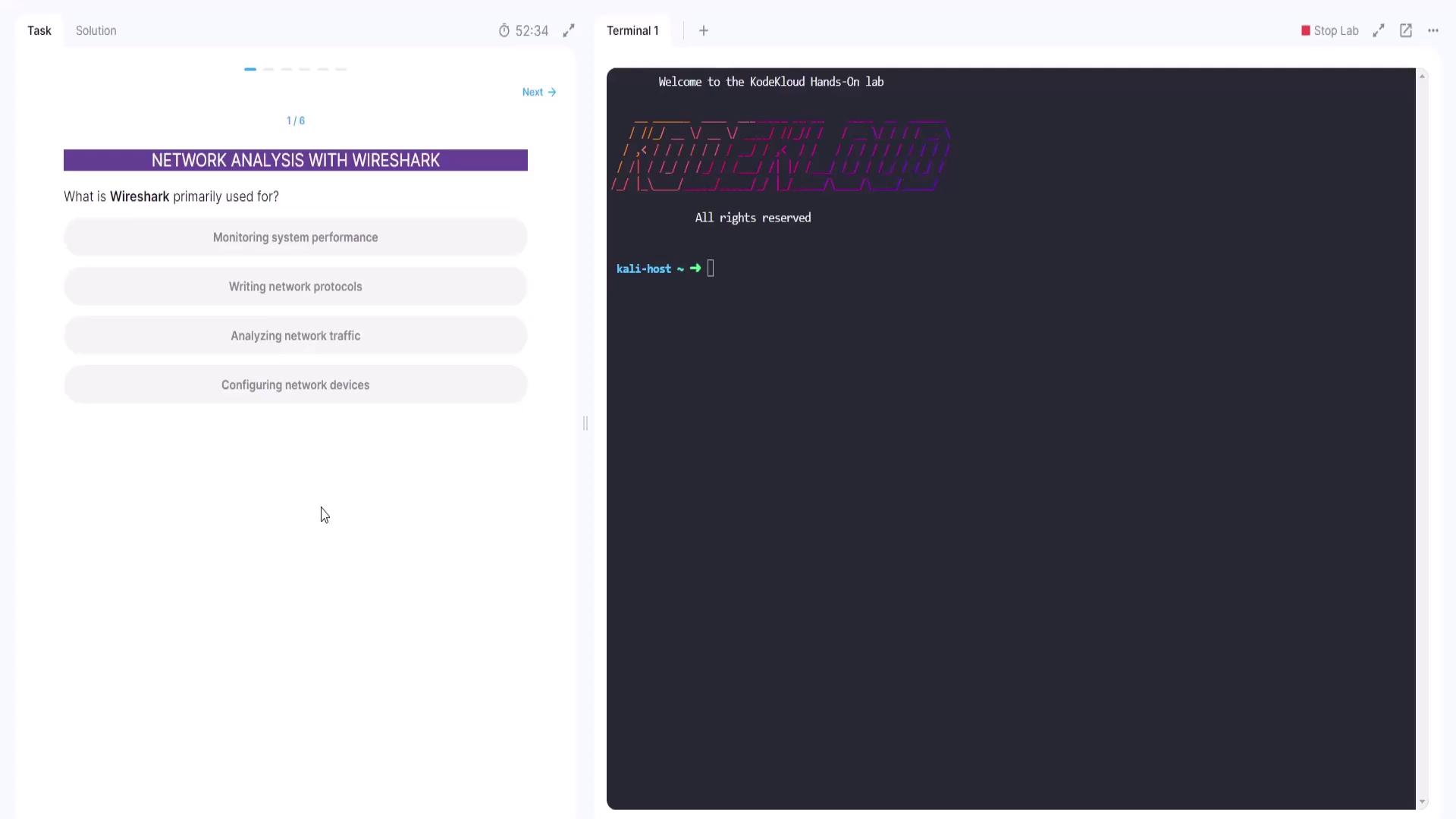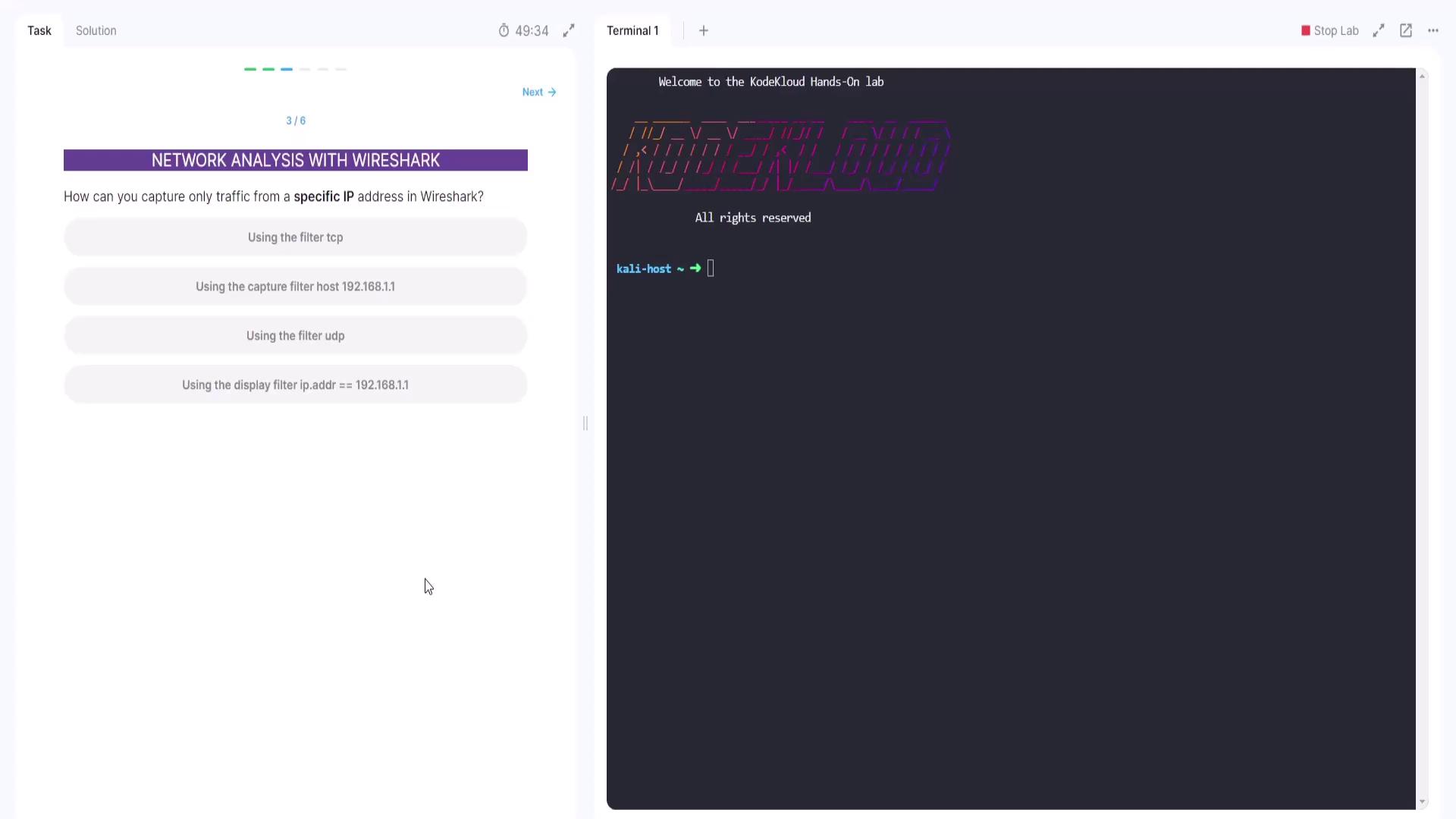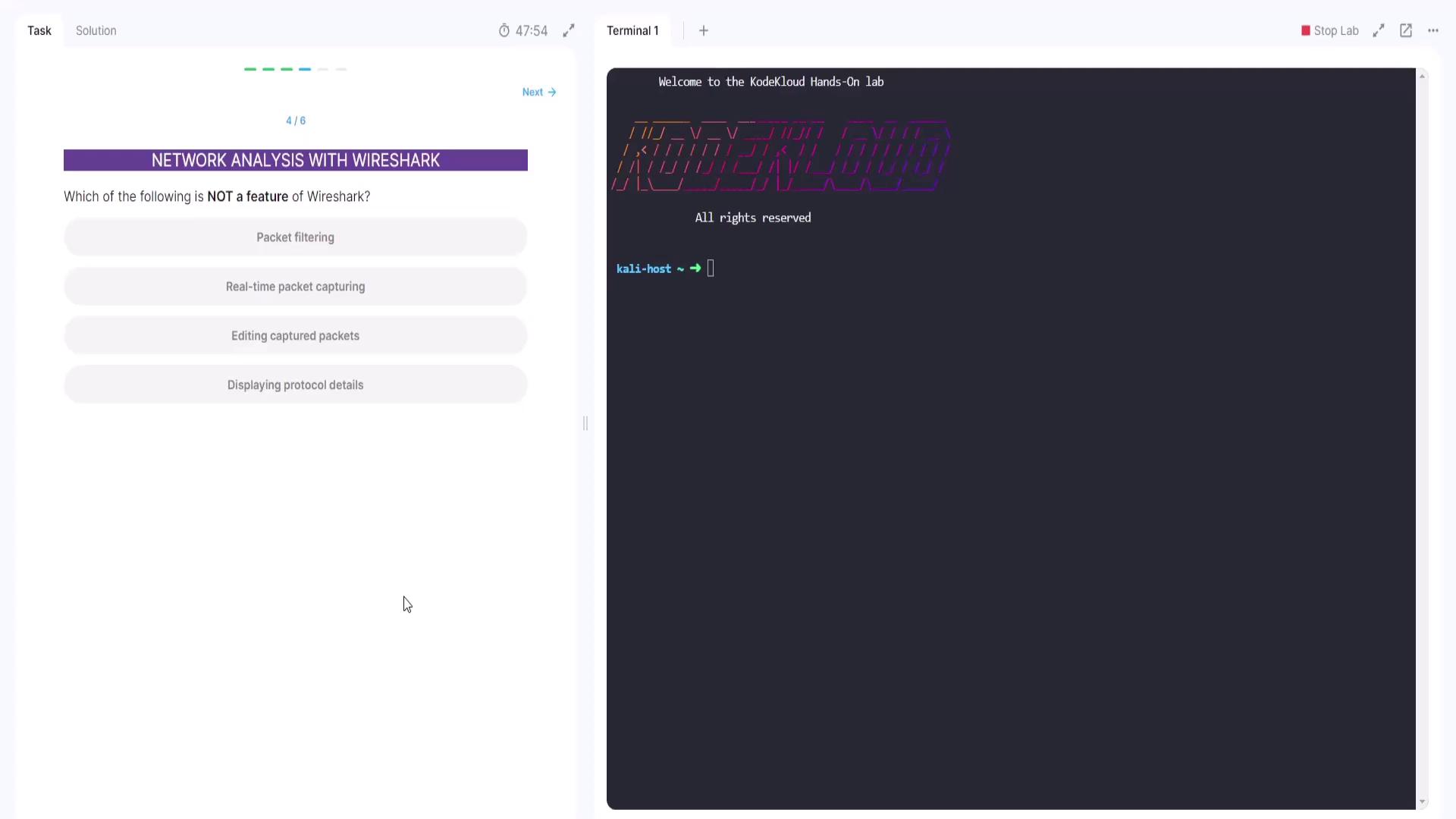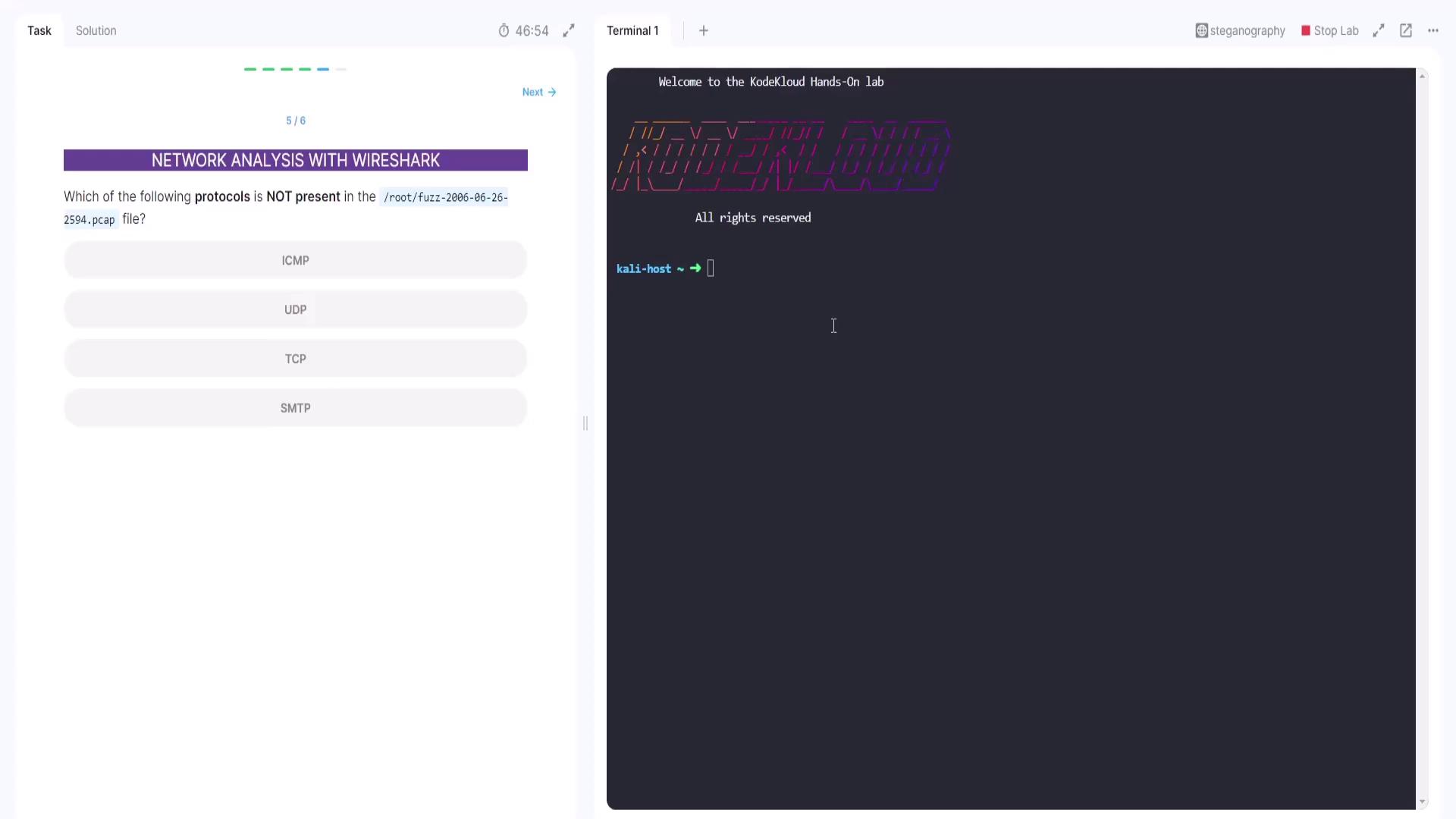CompTIA Security+ Certification
Threats Vulnerabilities and Mitigations
Demo Network Analysis Using Wireshark
Welcome to our network analysis demo using Wireshark—a powerful tool for investigating network communication and troubleshooting connectivity issues. In this guide, we will explore practical scenarios using Wireshark and its terminal-based variant, Tshark. Whether you're troubleshooting network problems or conducting cybersecurity investigations, this demo will equip you with valuable insights and hands-on experience.
Before jumping into the hands-on labs, let’s answer some fundamental questions about Wireshark to reinforce your understanding.
Question 1: What is Wireshark Primarily Used For?
The first query in our hands-on lab asks:
Which of the following is the primary application of Wireshark?
- Monitoring system performance
- Writing network protocols
- Analyzing network traffic
- Configuring network devices
Wireshark is specifically designed for analyzing network traffic. Unlike the other options, it is not built to monitor system performance, write protocols, or configure devices.

Question 2: Filtering HTTP Traffic in Wireshark
Next, consider the following question:
Which filter in Wireshark would you apply to display only HTTP traffic?
- ip.port == 80
- HTTP
- ip.address == 192.168.1.1
- DNS
Reviewing the options:
- The DNS filter only shows DNS traffic.
- The ip.address == 192.168.1.1 filter limits the view to a particular IP address.
- The ip.port == 80 filter is not as precise for HTTP, which is better targeted with the HTTP protocol filter.
Therefore, the correct filter to display only HTTP traffic is simply HTTP.

Question 3: Capturing Traffic from a Specific IP Address
The third question in our lab is:
How can you capture only traffic from a specific IP address in Wireshark?
- Using the filter TCP
- Using the capture filter host 192.168.1.1
- Using the filter UDP
- Using the display filter ip.address == 192.168.1.1
Using TCP or UDP filters would restrict the view based on protocol, while the display filter (ip.address == 192.168.1.1) only affects the already captured data. To capture traffic exclusively from a specific IP right from the start, you should use the capture filter:
Note
Use the capture filter "host 192.168.1.1" to ensure that only traffic from the specified IP is captured.

Question 4: Identifying Non-Features in Wireshark
The fourth question asks:
Which of the following is NOT a feature of Wireshark?
- Packet filtering
- Real-time packet capturing
- Editing captured packets
- Displaying protocol details
Wireshark provides extensive capabilities for packet filtering, real-time packet capturing, and protocol analysis. However, it does not support modifying or editing the captured packets. Thus, the correct answer is Editing captured packets.

Question 5: Analyzing Protocols in a Capture File
This question presents a hands-on lab challenge regarding protocols present in a capture file.
You have a capture file (ending with .pcap) on the Kali host and a terminal window open. Your task is to analyze the file and identify which protocol is absent from the capture. The options provided are:
- ICMP
- UDP
- TCP
- SMTP
Since you’re using a Linux terminal, Tshark is the tool of choice for this analysis. To get started, check the usage of Tshark with the following syntax:
tshark [ -i <capture interface> ] [ -f <capture filter> ] [ -2 ] [ -r <infile> ] [ -w <outfile> ] [ options ] [ <filter> ]
tshark -G [ <report type> ] [ --elastic-mapping-filter <protocols> ]
tshark -h | --help
tshark -v | --version
Next, read the capture file (e.g., fuzz-2006-06-26-2594.pcap) using Tshark:
tshark -r fuzz-2006-06-26-2594.pcap
To reduce the amount of output, use the -q option:
tshark -r fuzz-2006-06-26-2594.pcap -q
Then, to display protocol hierarchy statistics without listing every packet, add the -z io,phs switch:
tshark -r fuzz-2006-06-26-2594.pcap -q -z io,phs
If you encounter an error due to a minor misspelling of the file name (for instance, missing a zero), correct the filename exactly as provided (i.e., fuzz-2006-06-26-2594.pcap) and run the command again. The resulting output will display various protocol statistics. By comparing the available protocols (ICMP, UDP, TCP, SMTP), it becomes evident that SMTP is not present.

Question 6: Determining the IP Address with the Highest Traffic
The final question of our demo is:
Which IP address has the highest amount of traffic in the Wireshark capture?
To answer this, begin by analyzing overall protocol statistics from the capture file using Tshark:
kali-host ~➜ tshark -r fuzz-2006-06-26-2594.pcap -q -z io,phs
This output provides details such as frame counts and byte counts for various protocols, similar to:
Running as user "root" and group "root". This could be dangerous.
Protocol Hierarchy Statistics
Filter:
eth frames:691 bytes:99997
ip frames:613 bytes:92457
udp frames:52 bytes:82530
nbns frames:102 bytes:9384
dns frames:21 bytes:1932
...
For detailed analysis of traffic by individual IP addresses, execute the command with the ip_hosts,tree option:
tshark -r fuzz-2006-06-26-2594.pcap -q -z ip_hosts,tree
This command generates statistics for each IP address seen in the capture file. From the detailed output, you should notice that the IP address 192.168.1.2 shows the highest traffic count.
A sample output may resemble:
kali-host ~ % tshark -r fuzz-2006-06-26-2594.pcap -q -z ip_hosts,tree
Running as user "root" and group "root". This could be dangerous.
IPv4 Statistics/All Addresses:
Topic / Item Count Average Min Val Max Val Rate (ms) Percent Burst Rate Burst Start
All Addresses 606
192.168.1.2 527 0.0004 100% 0.3000 94.154
192.168.1.1 306 0.0003 86.96% 0.2500 94.154
192.168.1.255 102 0.0001 56.50% 0.2300 525.361
212.242.33.35 72 0.0001 16.84% 0.2300 1116.969
147.234.1.253 42 0.0000 6.93% 0.2200 94.154
...
67.168.1.1 1 0.0000 0.17% 0.1000 944.266
192.168.1.2 1 0.0000 0.17% 0.1000 1527.872
This confirms that 192.168.1.2 is responsible for the highest amount of traffic in the capture file.
Note
Always verify the accuracy of the capture file name and the paths provided in your lab instructions to avoid file-not-found errors.
That concludes our network analysis demo using Wireshark. Stay tuned for additional exam insights and more hands-on labs. Happy analyzing!
For more information on Wireshark and network analysis best practices, consider exploring the following resources:
Happy networking!
Watch Video
Watch video content
Practice Lab
Practice lab